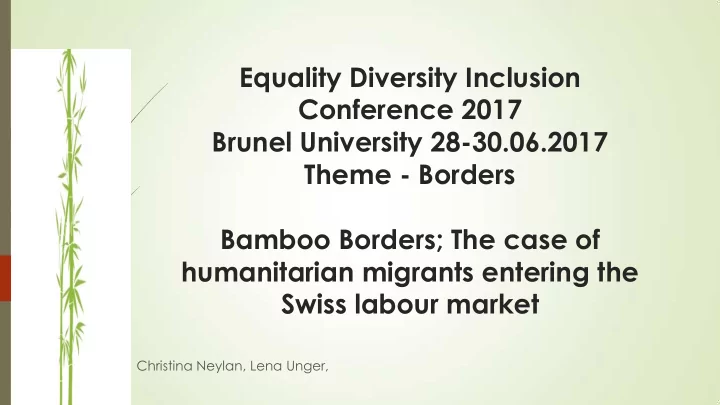

Equality Diversity Inclusion Conference 2017 Brunel University 28-30.06.2017 Theme - Borders Bamboo Borders; The case of humanitarian migrants entering the Swiss labour market Christina Neylan, Lena Unger,
Overview I stand tall like a bamboo tree Background to migrants in Swiss labour market Methodology Findings Summary Discussion
I STAND TALL LIKE A BAMBOO TREE by poet MariaDiding SajSam I stand tall like a bamboo tree, Strong winds make my body to sway, Storm makes me blown away, But I still stand like a bamboo tree. Trials, problems that I faced everyday, I have the strength to pursue it anyway, The dreams that I have in mind, Though it’s simple but it's one of a kind.
Purpose The paper examine the situation concerning employment of humanitarian migrants in the Swiss labour market. Consideration is given to the lack of skilled labour in the market, the perspectives from potential employers in the agriculture, hospitality, logistics and health care industries, and possible solutions to overcome the problems.
Switzerland as an immigration destination It was only at the end of the 19th century that Switzerland became a country of immigration (Straubhaar, 1994) 26.3% pop. foreigners in 2015 Fear of foreignerisation (Uberfremdung), Need for migrant workers Swiss migration policies
Swiss migration waves 1980 Increase in asylum seekers from Eastern European 1990 Aftermath of the Persian Gulf War 2000 -2007 Family reunification (40%), work (25%) training (12%) 2007 Eretria, Somalia, Iraq, Serbia and Sri Lanka 2015 Syrian conflict, Iraq and Afghanistan crisis 2016 African influx *** 2015 14,164 admitted persons
Terminology “ Owing to a well-founded fear of being persecuted for reasons of race, religion, nationality, membership of a social group or political opinion, is outside the country of his nationality, and is unable to or owing to such fear, is unwilling to avail himself of the protection of that country ” (UNHCR, “Flowing Across Borders”, n.d., para. 3) Asylum Seeker V Refugees Asylum seeker is a person who has applied for asylum on the ground that if he is returned to his country of origin he may be subjected to persecution. Refugee is an asylum seeker whose application has been successful – person fleeing war or natural disaster. Humanitarian migrant is a person who has left his home and seeks employment in another country. Many asylum seekers are such migrants who claim asylum.
Terminology “.. the difference is asylum seekers claim to be refugees, while a refugee is an asylum seeker whose claim to be a refugee has been evaluated and confirmed by the system they seek asylum in.” UNHCR (Asylum-Seekers, para. 1). Recognised Refugee (RR) refers to a person that meets the condition that defines a refugee. Provisionally admitted (PA) status refers to a person whose request for asylum has been rejected and if they cannot be reasonably rejected they receive a provisional permission residence permit F . Terms refugee and migrant blur in practice, Long argues that the term refugee prevents proper integration into society, whereas the term migrant omits the humanitarian motives but includes the intention of integration (Long, 2013, p. 21).
Swiss migration case Asylum Seekers (AS) receive a residence permit N which allows the bearer to work after 3 months. In case of rejection can work after 6 months. If rejected becomes a “hardship case”. Such cases are only allowed to work in industries with a lack of skilled labour. Employment is only possible if no native resident has applied for the position (Thier, 2015, para. 13). Individual cantons decide how easily AS`s access the labour market.
Swiss case 4 Industries Agriculture Logistics Hospitality Health care
Methodology Qualitative methods Empirical study Strategic sample 9 interviews 4 industries Semi -structured interviews Data analysis Questions centred around expertise employing humanitarian migrants, recruiting process, problems, integration methods applied.
Findings Integration potential “You can also look at history, the Italians built the Gotthard tunnel; today they are integrated into the Swiss society.” Lack of skilled labour in the Swiss market Factors contributing to preventing employment Language, cultural differences, trauma, validity of working papers, uncertainty re length of stay, Non-awareness of employment opportunity Lack of standardization integration policies
Findings How to overcome obstacles Training courses; language and culture courses State help in case of psychological treatment Standardize programmes across various cantons
Challenges Cultural differences Awareness and sensitivities to religious and cultural difference. “Because these people come from completely different parts of the world, from different cultures, and have no idea of the work culture in Switzerland. Indeed they do not understand the differences in hierarchies, the position of women as co-workers and especially as bosses.” (hospitality employer).
Challenges “ The internship training lasts six months and includes intercultural training as one part of the programme. Participants are introduced to Swiss work ethics, such as, what do I have to watch out for at work, punctuality, reporting absence when ill, things like that, but also more general things like, how does a team function in Switzerland and what is team work in Switzerland. These things are very important .” (logistic company employer) Low level of skills of humanitarian migrants
Discussion Desire to employ humanitarian migrants IC Training for employers, employees & humanitarian migrants Need for participation from other industries Seasonal nature of work Bureaucracy
Conclusion & Limitations What is the humanitarian migrant perspective Speak with other industries (4) Investigate reasons behind low employment rate of migrants Standardised programmes across cantons
Recommend
More recommend